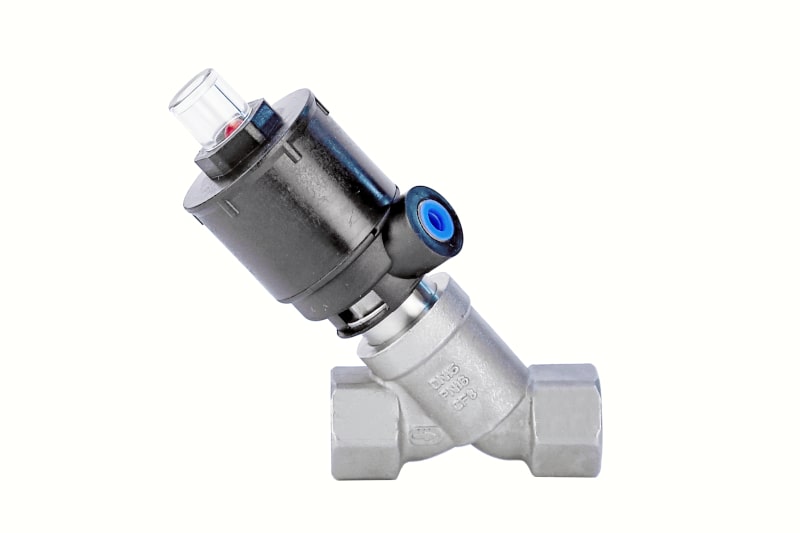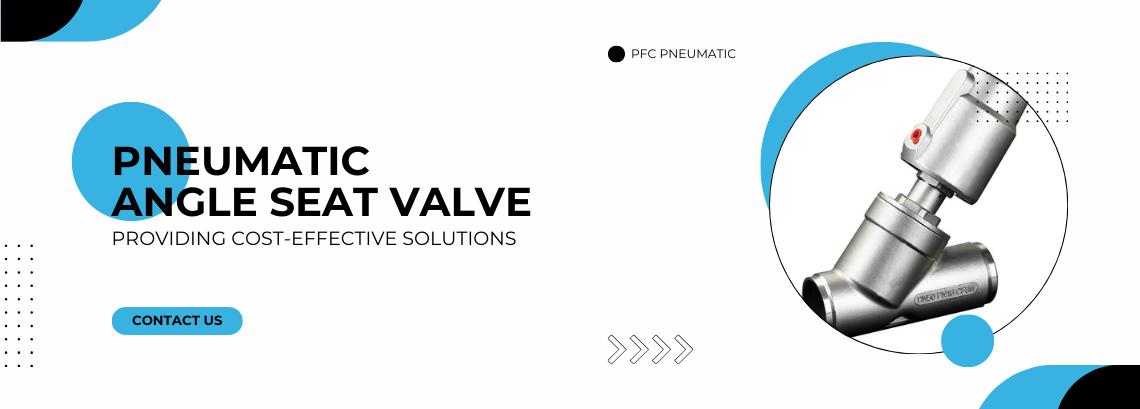
Leading Y-Type Seat Valve Manufacturer and Exporter in China
Are you in need of high-performance y type angle valve for industrial applications? Or are you looking to upgrade to more efficient, durable globe valves that can handle challenging conditions? Explore our BRS range of y type angle seat valves to find the ideal solution for your business needs. We offer a wide selection of angle seat valves in 2024 at competitive prices, ensuring your projects are both cost-effective and top-quality.
At BRS, we specialize in providing angle seat valves for a variety of demanding applications. Our products are available in multiple materials—plastic, stainless steel, brass, and aluminum—so you can choose the best option for your operating environment. Each valve in our lineup is designed to withstand high pressure, high temperature, and corrosive conditions, making them suitable for complex and rigorous applications.
If you’re ready to enhance your system’s reliability and efficiency, get in touch with our valve specialists today. We’re here to help you choose the best angle seat valve that fits your exact requirements and budget.
What Y Type Angle Seat Valves Can We Provide?
| Connection Port | Valve type | Material | Features | Drive | Size |
|---|---|---|---|---|---|
| Thread | Three-way | Plastic | High pressure | Manual | Customizable |
| Welding | Two-way | Stainless steel | High temperature | Automatic | |
| Clamp | Brass | Anti-corrosion | |||
| Flange | Aluminum |
High Quality Y Type Angle Seat Valve for Sale
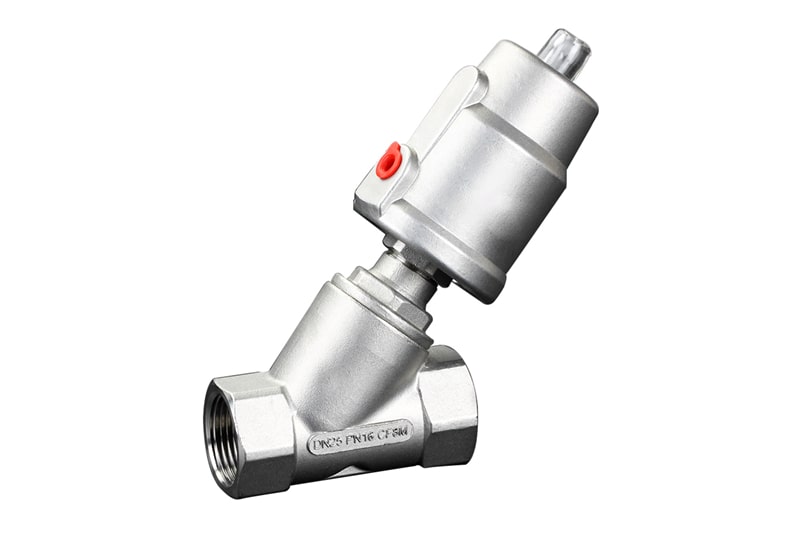
Designed for quick and secure installation, this threaded model ensures tight sealing and efficient flow regulation. Ideal for general-purpose industrial use.
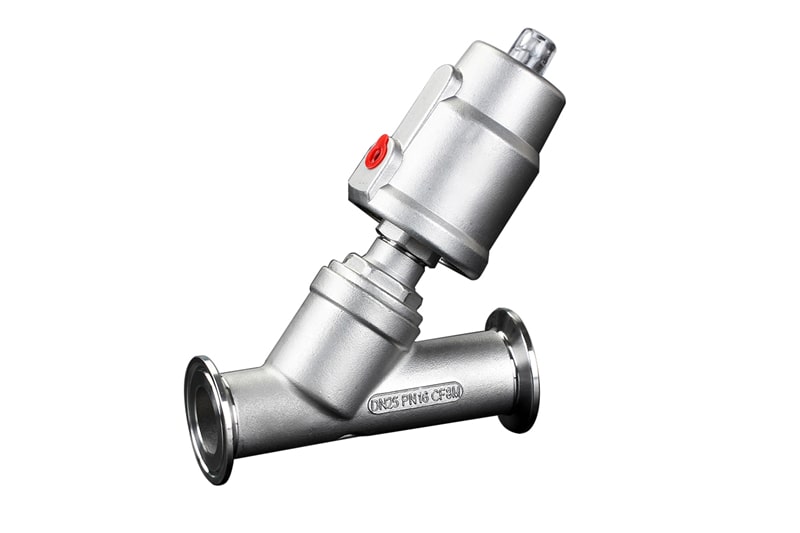
Featuring hygienic tri-clamp connections, this variant is perfect for food, beverage, pharmaceutical, and biotech industries. It supports easy disassembly and cleaning.
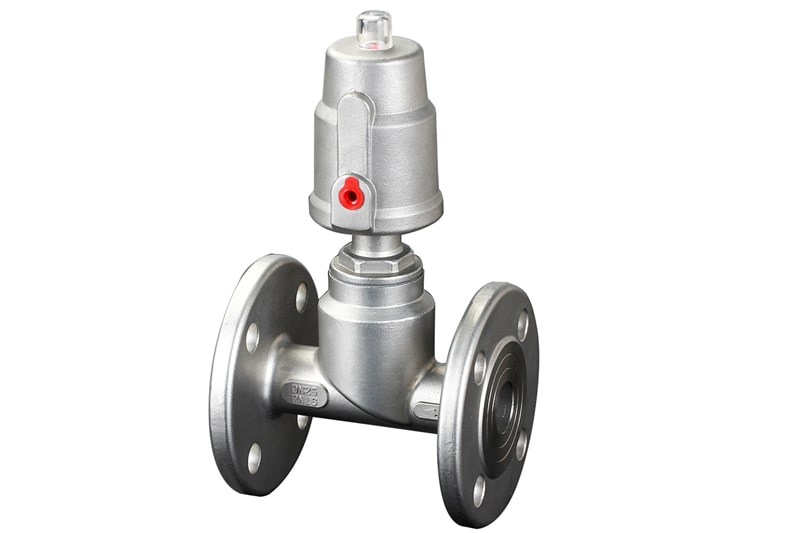
Built for robust pipeline integration, the flanged design ensures secure, vibration-resistant installation in heavy-duty industrial environments.
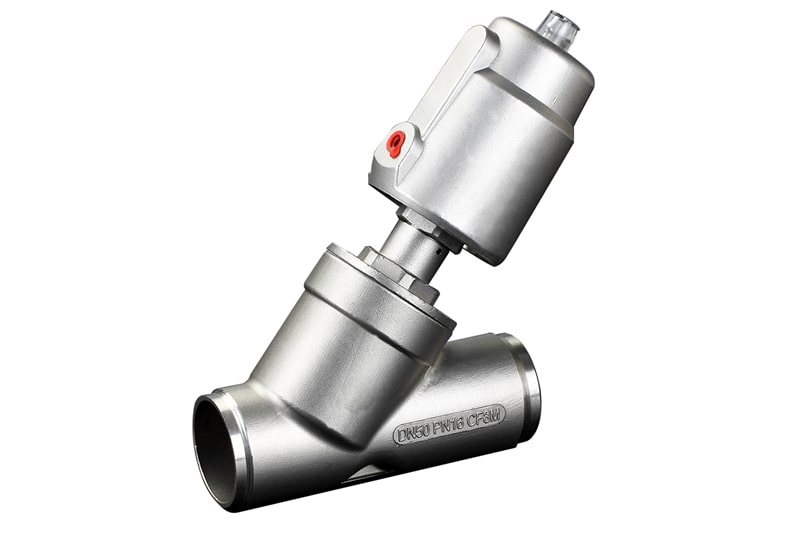
Designed for leak-proof, permanent installations, this welded version is ideal for high-temperature and high-pressure applications.
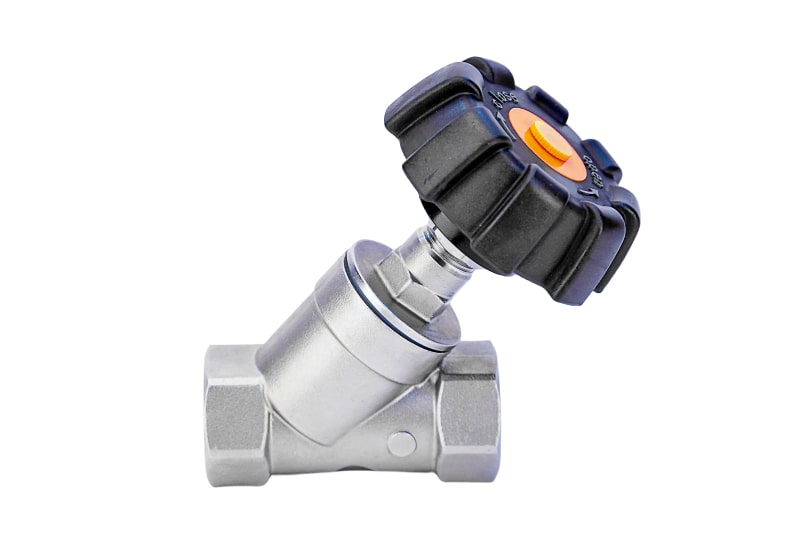
2/2 Way Y Type Angle Seat Valve
With two ports and straight-through flow, this 2/2 way design enables precise on/off control, making it suitable for automation in compressed air or water systems.
About the Advantages of Our Y Type Angle Seat Valve
As a trusted pneumatic angle seat valve manufacturer, we offer unique cost-effective advantages that make our products stand out. That's why our pneumatic angle seat valves are your ideal choice!
Advantages of Our Y Type Angle Seat Valves
Our Y-Type Angle Seat Valve offers a range of distinct advantages that make it the preferred choice for industries requiring precision, durability, and efficiency. Designed to handle high-pressure systems and aggressive fluids, this valve's unique Y-shaped body ensures optimal flow control and minimal turbulence.
The robust construction guarantees a long operational life, even in demanding environments, while its compact design enables easy installation and space optimization. The angle seat design reduces wear and tear, extending valve longevity. Additionally, our Y-Type Angle Seat Valve features quick and reliable sealing, preventing leaks and ensuring superior performance with minimal maintenance.
Whether you're managing steam, water, or other critical fluids, our valve delivers unparalleled reliability and efficiency.
Applications of Our Y Type Angle Seat Valves
Buy our angle seat valves and you can use them in these fields:
| Industry | Applications | Industry | Applications |
|---|---|---|---|
| Food & Beverage | Bottling and dispensing equipment, fluid control, steam cleaning systems | Oil & Gas | Pipeline control, lubrication systems, and fluid transfer |
| Pharmaceutical | Sterilizers, autoclaves, clean-in-place (CIP) systems, process control | Medical & Healthcare | Autoclaves, laboratory equipment, sterilization processes |
| Textile | Dyeing and drying machines, fabric steaming, and textile finishing | Pulp & Paper | Steam handling, fluid processing, and paper drying systems |
| Automotive | Paint spraying, washing systems, and air drying equipment | Agriculture | Irrigation systems, fertilizer and pesticide dispensing |
| Chemical Processing | Chemical dispensing, mixing equipment, and reactor control | Electronics Manufacturing | Soldering equipment, air cleaning, and process drying |
| Water Treatment | Filtration systems, wastewater treatment, and flow control in piping | Power Generation | Boiler control, steam turbines, and cooling systems |
| HVAC | Steam and hot water systems, air handling, and drying systems | Marine & Shipping | Bilge water handling, cargo cleaning, and steam control |
| Printing & Packaging | Ink and paint dispensing, printing machinery, and packaging line automation | Mining & Metals | Dust suppression, ore washing, and steam distribution |
| Industrial Cleaning | Barrel cleaners, automated wash systems, and detergent dispensing | Laboratory Equipment | Fluid dispensing, sample washing, and sterilization units |
Beginner's Guide to Buying a Y Type Angle Seat Valve
If you want to purchase a large number of Y Type angle seat valves for your own projects in the near future, then it is recommended that you read the following content. It can help you better understand and choose Y Type angle seat valves.
1. How Does a Y-Type Angle Seat Valve Work?
A Y-Type Angle Seat Valve is a flow control valve with a distinctive Y-shaped body, designed for high-pressure applications. Its angled design allows for smooth, efficient fluid flow and reduces turbulence, which helps minimize wear and tear. These valves are durable, reliable, and ideal for handling aggressive or high-temperature fluids like steam, water, and chemicals. They are widely used in industries requiring precise flow control, including manufacturing, food processing, and pharmaceuticals.
1.1 Flow Path:
The valve body is designed in a Y-shape, with the seat positioned at an angle (typically 45°). This design minimizes flow resistance and pressure drop, allowing high flow rates with compact valve size.
1.2 Actuation (Pneumatic or Electric):
- The valve is typically operated using a pneumatic piston actuator.
- When compressed air is supplied to the actuator, the piston moves upward, lifting the stem and plug assembly away from the seat — opening the valve.
- When air pressure is released or reversed, a spring or air signal pushes the piston back down, closing the valve as the plug is pressed onto the seat.
1.3 Seat and Seal:
The sealing element (usually made of PTFE or other high-performance materials) ensures tight shutoff when the valve is closed.
1.4 Fail-Safe Options:
Depending on the actuator type, the valve can be configured to be normally closed (NC) or normally open (NO) when not actuated:
- NC (normally closed): Valve remains closed when no air pressure is applied.
- NO (normally open): Valve remains open when no air pressure is applied.
Why Choose a Y-Type Angle Seat Valve?
Selecting the right Y valve is essential to ensuring smooth, efficient, and long-lasting performance of your system. Let’s explore the key reasons to choose a Y-type angle seat valve, and the wide range of applications where it truly shines.
1. High Flow with Low Pressure Drop
The Y-shape design minimizes turbulence and resistance, allowing for high flow rates — even in compact sizes. Compared to globe valves, Y-type valves maintain smoother, straighter fluid paths.
2. Fast, Reliable Operation
With a pneumatic actuator (or electric in some versions), the valve opens and closes rapidly, making it ideal for automated systems and high-cycle applications.
3. Long Service Life
These valves are engineered for durability. They typically use stainless steel bodies and PTFE seals, which can handle high temperatures, aggressive media, and thousands of open-close cycles without wearing out.
4. Self-Draining Design
In vertical installations, the angle allows media to fully drain out of the valve body — crucial in sanitary processes like food and beverage, pharmaceuticals, or CIP (clean-in-place) systems.
5. Compact and Space-Saving
Despite their high performance, Y-type valves are relatively compact and ideal where space is limited.
6. Multiple Mounting Options
Threaded, flanged, tri-clamp, and welded connections make them easy to install in a variety of industrial and sanitary pipelines.
Difference Between 2-Way and 3-Way Y-Type Angle Seat Valves
Quick Comparison Table:
| Feature | 2-Way Y-Type Valve | 3-Way Y-Type Valve |
|---|---|---|
| Number of Ports | 2 (inlet + outlet) | 3 (1 common + 2 inlets/outlets) |
| Flow Function | On/Off flow control | Flow switching, diverting, or mixing |
| Flow Direction | One-directional | Multi-directional |
| Use Case | Simple shut-off or control systems | Media redirection, alternating flow, or mixing |
| System Complexity | Simple, compact design | More complex, supports multiple flow paths |
| Typical Applications | Steam, water, air pipelines | Filling machines, cooling circuits, process routing |
What is a 2-Way Y-Type Angle Seat Valve?
A 2-way Y-type angle seat valve features two ports: one inlet and one outlet. It is primarily used for on/off control in pipelines where fluid, gas, or steam flows in a single direction.
These valves are ideal for:
- Steam systems
- Water or air supply lines
- Chemical dosing
- Automated industrial equipment
The valve operates through a piston actuator that lifts or lowers the sealing plug to either allow or block the flow. Thanks to its streamlined Y-shape and angled seat, it enables high flow rates with low pressure loss, all while maintaining compact dimensions.
Advantages:
- Simple to install and maintain
- Fast response time
- Available in normally open or normally closed types
- Long-lasting performance under frequent cycling
What is a 3-Way Y-Type Angle Seat Valve?
A 3-way Y-type angle seat valve has three ports and serves to divert, mix, or alternate the flow of media between different channels. These valves can route one input to two different outputs, or vice versa, depending on the internal flow path and configuration.
This valve type is commonly used in:
- Filling and bottling machines
- Process automation systems
- Cooling/heating loops
- Switching between process lines
By combining multiple functions into one valve, 3-way designs help reduce the need for extra piping and components, saving space and simplifying system design.
Advantages:
- Supports dynamic flow routing
- Reduces valve count in complex systems
- Suitable for space-saving, compact setups
- Excellent for batch processing and multi-line controls
Final Tip:
Choose a 2-way Y-type valve when you need fast, reliable flow control in a single direction.
Choose a 3-way Y-type valve when your system needs multi-path control like diverting, mixing, or alternating between flows.
What Is the Difference Between a 2-Way and 3-Way Y-Type Angle Seat Valve?
Quick Comparison Table
| Feature | 2-Way Y-Type Valve | 3-Way Y-Type Valve |
|---|---|---|
| Number of Ports | 2 (Inlet + Outlet) | 3 (1 Common + 2 Inlets/Outlets) |
| Function | On/Off Flow Control | Diverting or Mixing Flow |
| Flow Direction | One-Way | Multi-Way |
| Typical Use | Basic Shut-Off Applications | Flow Switching Between Lines |
| System Complexity | Simple | More Complex |
| Common Applications | Steam, Water, Air Lines | Filling, Mixing, Diverting Systems |
2-Way Y-Type Angle Seat Valve
A 2-way Y-type angle seat valve is designed with two ports—one for the inlet and one for the outlet. It is primarily used to control the start or stop of flow in a single direction. These valves are ideal for applications involving steam, water, air, or inert gases where fast, frequent opening and closing is required.
The valve is actuated pneumatically or electrically, and when opened, the piston lifts the plug off the seat to allow flow. When closed, the piston pushes the plug back onto the seat to stop the flow.
3-Way Y-Type Angle Seat Valve
A 3-way Y-type angle seat valve has three ports and is used to either divert flow from one inlet to two different outlets, or to mix two inlet flows into one outlet. This makes it suitable for more complex flow control systems, such as process automation, mixing tanks, or alternating between multiple product lines.
Depending on the internal design, 3-way valves can switch, mix, or alternate the flow direction automatically, offering flexibility and space-saving advantages in piping layouts.
Final Tip:
If your system requires simple on/off control for one fluid path, choose a 2-way Y-type valve. If your application needs flow switching, diversion, or mixing between multiple lines, a 3-way Y-type valve is the better option.
Top Y-Type Angle Seat Valve Manufacturers and Brands
Summary of Brands at a Glance
| Brand/Manufacturer | Established | Specialty & Strengths |
|---|---|---|
| Gemu | 1982 | High-precision control valves |
| SMC | 1985 | Industrial pneumatic solutions |
| Burkert | — | High-cycle, high-flow Y‑pattern valves |
| ASCO (Emerson) | 1969 | Broad automation valve lines |
| Emerson / Spirax Sarco | — | Steam and thermal control valves |
| Valworx | — | Durable industrial valves |
| Kingston | 1908 | Municipal and industrial valve systems |
| ESG (China) | 2001 | Stainless steel pneumatic angle seat valves |
| Wellgreen (China) | 2005 | Energy-efficient industrial valves |
| Tameson | — | Global valve distributor with wide range |
Leading Manufacturers & Brands:
Gemu
A global valve specialist since 1982, Gemu is known for producing high-precision flow control solutions, including Y‑Type angle seat valves with robust quality and consistent performance.
SMC Corporation
A major player in automation and pneumatic equipment, SMC offers Y‑Type pneumatic angle seat valves designed for high-cycle, industrial uses.
Burkert
Known for its long-established Type 2000 series, Burkert provides high-performance Y‑Pattern Angle Seat Valves with excellent flow rates and durability.
ASCO (Emerson)
ASCO, part of Emerson, offers a wide range of fluid control valves, including reliable and efficient angle seat valves for automation systems.
Emerson (Spirax Sarco)
Spirax Sarco under Emerson specializes in steam system control and produces robust Y-type valves for thermal applications.
Valworx
A trusted name in industrial valves, Valworx manufactures angle seat valves with durable designs and fast actuation for automation.
Kingston Valves
Established in 1908, Kingston offers high-quality angle seat valves used in municipal and heavy industrial applications.
ESG (Qingdao Elite Machinery)
A Chinese manufacturer specializing in stainless steel pneumatic Y-type valves, ESG serves industries like chemicals, food processing, and water treatment.
Wellgreen (Wenzhou)
A leading Chinese supplier producing energy-efficient Y-type valves for industrial systems such as chemical and thermal fluid lines.
Tameson
A European distributor offering a variety of Y-type angle seat valves from brands like Bürkert and Gemu, with fast availability and global shipping.
2. Key Factors to Consider
Before purchasing a Y-Type Angle Seat Valve, there are several key factors you should evaluate to ensure you select the right valve for your needs.
1. Fluid Type and Compatibility
-
What fluid will pass through the valve?
Different fluids require different materials for compatibility. For example, steam, chemicals, water, and air all have varying corrosive effects and temperature requirements. Ensure that the valve material can handle the specific fluid in your system. -
Material Choices:
Common materials include stainless steel for steam and chemical resistance, brass for lower pressure systems, and plastic for non-corrosive, low-pressure fluids. Stainless steel is the most widely used material for industrial Y-Type Angle Seat Valves due to its corrosion resistance, high temperature endurance, and durability.
2. Pressure and Temperature Requirements
-
Operating Pressure:
Choose a valve rated for the pressure in your system. If the system operates under high pressure, select a valve with a high-pressure rating. Y-Type Angle Seat Valves are well-suited for pressures ranging from low to very high, depending on the material and construction. -
Temperature Range:
The valve should be able to handle the temperature of the fluid passing through. For steam systems or hot water applications, select a valve with a high-temperature tolerance.
3. Valve Size
- The valve size should match the size of your pipeline. Selecting a valve that is too large or too small can cause issues like excessive pressure drop, inefficient flow, or mechanical stress. To avoid these issues, check the pipe diameter and flow requirements of your system before purchasing the valve.
4. Actuation Type
-
Manual Actuation:
If you are managing a system that doesn't require frequent or automatic changes to the flow, a manual actuator may suffice. Manual valves are simple and cost-effective, but they require human intervention to open or close. -
Pneumatic Actuation:
Pneumatic actuators use compressed air to open or close the valve. This type of actuation is common in industrial automation, where remote operation is necessary. -
Electric Actuation:
Electric actuators are ideal for more complex control systems that require precision and remote monitoring. They provide accurate control over flow and can be integrated with advanced control systems.
5. Material and Construction
- Stainless Steel is the most popular choice for high-corrosion resistance, strength, and temperature resistance, making it ideal for steam, chemicals, or abrasive applications.
- Brass and Bronze are typically used for lower-pressure applications and are more affordable options.
- Plastic or PVC options are available for low-cost, low-pressure, or non-corrosive fluid systems.
6. Certifications and Standards
-
Industry Certifications:
Ensure that the valve meets relevant industry standards (e.g., ISO, API, FDA for food-grade applications). This is especially important for industries like food processing, pharmaceuticals, or water treatment, where regulatory compliance is critical. -
Quality Certifications:
Look for CE marking and ISO certification for guaranteed product quality, ensuring long-term reliability and performance.
Bulk Purchase Pricing for Y-Type Angle Seat Valves
Bulk Price Overview
| Valve Type | 1–50 pcs Price | 100–500 pcs Price | 500+ pcs Price |
|---|---|---|---|
| Sanitary 304 SS | ~US$50–65 | ~US$60 | ~US$50 |
| 316L Flange, Sanitary | ~US$40 | ~US$35 | ~US$30 |
| 304/316 Threaded or Welded | ~US$7–25 | ~US$6.9–20 | Lower end of range |
| Plastic DN32 Valve | ~US$26 | ~US$24 | — |
| Brass or Low-Grade Material | ~US$4–8 | — | — |
Buying Tips
- Material & Connection Type: Stainless steel valves (especially 316 or tri-clamp/flange) are more expensive than brass or plastic versions.
- Quantity Discounts: Expect price drops of 25–40% when ordering over 500 units.
- Specifications: Always confirm valve size, body material, actuator type, and any required certifications like FDA or CE.
- Shipping & Terms: Inquire about shipping costs, lead times, payment terms, and quality control options (e.g., third-party inspection).
If you need help contacting suppliers or requesting formal quotations for your project, feel free to reach out!
Tips for Beginners When Buying
1. Know Your System Requirements
- Before purchasing, carefully evaluate your system’s pressure, temperature, fluid type, and flow requirements. Understand the specific environment and media the valve will handle, as this directly impacts your choice of material and actuator type.
2. Focus on Quality Over Price
- While Y-Type Angle Seat Valves can vary in price, investing in a high-quality valve will save money in the long run by reducing maintenance costs and avoiding premature replacements.
3. Don’t Hesitate to Ask for Guidance
- If you're unsure, consult with valve suppliers or manufacturers. They can help you choose the right valve size, material, and actuator for your application. Many companies offer expert advice to guide beginners through the selection process.
4. Check After-Sales Support
- Ensure that your supplier provides reliable after-sales support and offers warranties. After-sales service is crucial for troubleshooting or replacement parts, especially in the event of a valve failure.
5. FAQ
Q: What is the difference between a Y-Type Angle Seat Valve and a straight-through valve?
A: The primary difference is the angle of the valve seat. A Y-Type valve has an angled design that reduces fluid turbulence and pressure drop, making it more efficient for high-pressure or high-temperature applications. A straight-through valve typically allows for a more direct flow but can create higher friction.
Q: Can I use a Y-Type Angle Seat Valve in low-pressure systems?
A: Yes, but it is most commonly used for high-pressure systems. If your system operates at lower pressure, there are other valve types that may be more cost-effective, but Y-Type valves will still work effectively.
Q: Are Y-Type Angle Seat Valves easy to maintain?
A: Yes, they are relatively easy to maintain. Regular cleaning and checking for leaks or wear on seals are essential to ensure the valve continues to perform optimally. Some valves also come with replaceable parts, reducing maintenance costs.
Related content recommendation
| Buy Pneumatic Angle Seat Valves at OMAL | AV-5AS sanitary pneumatic angle seat valve |
|---|---|
| 3/4 inch pneumatic angle seat valve single-acting NC | 1" Pneumatic Angle Seat Valve, 2 Way, 2 Position |
Want the Lowest Price Y Type Angle Seat Valve?
Click the button to contact us, you will get free solutions, expert guidance, and the latest quotation


